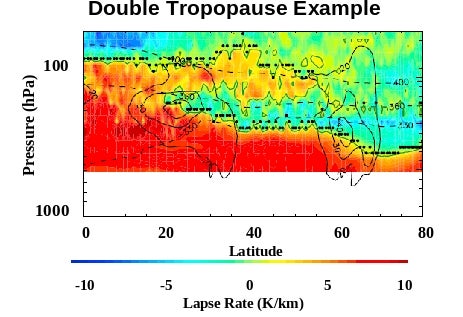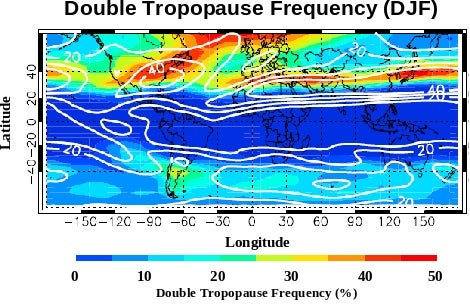Aura/HIRDLS reveals global characteristics of the double tropopause
Aura’s High Resolution Dynamics Limb Sounder (HIRDLS) reveals the global pattern of the double tropopause using the HIRDLS high vertical resolution profiles. Composition and structure near the tropopause are important for the Earth radiative balance and quantifying transport of ozone and other stratospheric species into the troposphere.
|
|
|
| Along track cross section of the lapse rate calculated from HIRDLS temperatures at 08:00 UTC on 1/26/2006. Black filled circles indicate the tropopause identified using the WMO double tropopause criterion. The green contour denotes 2K/km. Zonal wind contours are solid black and potential temperature contours are dashed black. | Double tropopause frequency of occurrence is obtained from HIRDLS Level 2 data 2005 – 2007 for December–January–February. In each 3° latitude by 15° longitude bin the frequency is the percentage of profiles with a double tropopause. White contours are the mean zonal wind (solid white lines), on the 200 hPa pressure surface. |
A prominent double tropopause is shown in the left figure. Northern hemisphere winter spatial variations of the chance for double tropopause occurrence are shown on the right. White contours are the seasonal mean zonal wind (m/s) at 200 hPa. HIRDLS measurements show that double tropopauses and hence air mass mixing are most likely to occur poleward of the subtropical jet during winter (red regions). HIRDLS measurements reveal the seasonal variation in double tropopause occurrence and also that interannual variability is largest during winter (not shown).
Reference:
Peevey, T., et al., (2012), Investigation of double tropopause spatial and temporal global variability utilizing High Resolution Dynamics Limb Sounder temperature observations, J. of Geophys. Res.


